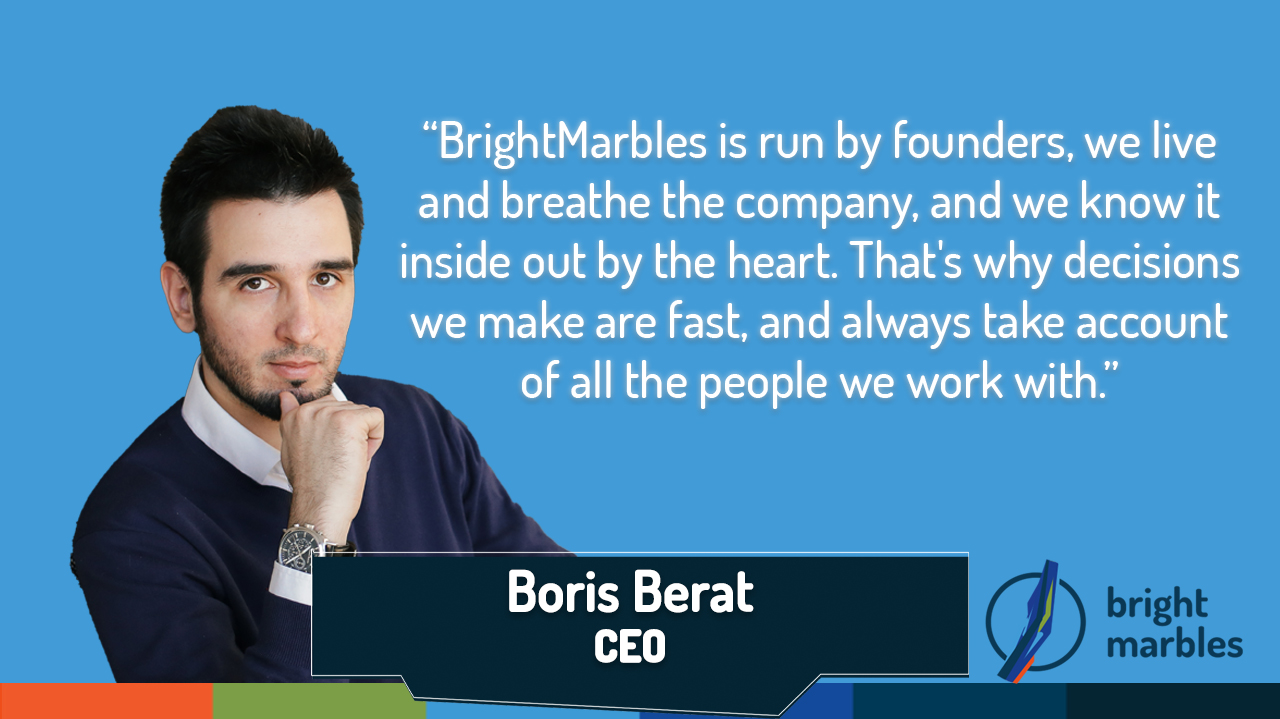
Whether you’re launching your startup from your living room with a small but mighty team or you already have a big team full of bright and dedicated employees, there’ll be a time when there’s more work to be done than hands to do it. Finding the right outsourcing partner to work with is like a marriage – it will make your life a whole lot easier, but only if you pick the right partner.
WHEN IS THE RIGHT TIME TO START LOOKING FOR AN OUTSOURCING PARTNER?
Let’s assume that your company is a tech startup. You went through all the famous stages. You had casual conversations about your brilliant product idea during romantic dinners or while cracking open a cold one with the boys. Sure, in most of the cases the brilliant idea that we scribbled on a restaurant napkin turns out not to be so bright after all. Let’s face it, a business will not stay open and be profitable just because you dreamed it would. However, despite your concerns that you will be rushed into a product that doesn’t fit a specific market, or that you and your colleagues will not have enough capacity or luck to go through it successfully, you decided to go with it.
Your journey wasn’t an easy one, in any case. Creating a successful company, especially in tech, requires a lot of hard work, time, and resources, and many wannabe founders and CEOs end up failing. That wasn’t the case for you. You started a successful business, and there’s nothing more rewarding than launching a startup from nothing and watching it grow.
You’ve built it up from the scratch, and no one can take this away from you. Now, when you have a product that fits market needs, a good short-term plan, a successful in-house team, you realize that you are still far from being the CEO of a stable company.
On the one hand, you have a great product and a limited budget for continuous development (regardless of how big your budget is). On the other hand, your growing competition is trying to offer a similar product to the same target group and throw you out of the game. That means you have to be better and faster than them. You need to offer new functionalities and better technology before they do, which means constant development without losing quality in the process. Most importantly, you have to continually worry about cost control and make sure that you don’t drain up your entire budget and go bankrupt.
So, suddenly the potential to scale your team up fast (with the option to scale down) starts to be one of your biggest concerns. This is the moment when you realize the actual cost of software development in the US or Western/Central Europe. Software engineers’ salaries, high taxes and employee benefit-related costs, tight labor regulations, and many other factors that make this market the most expensive one, could greatly slow down, limit, and, in the worst case, completely stop the development of your product and jeopardize your company’s business.
That is when you need to decide either to hire an in-house development team or to outsource to a software house. Even if you are one of the entrepreneurs who believe that having a team of in-house developers is a safer way to get things done, you will quickly realize that sometimes there’s no need to pay more money to hire an employee from your country (if it is even possible to employ a competent professional with expertise you want in your region at that particular moment) if you can get a software engineer with the same or even higher expertise level elsewhere.
Let’s say my assumption isn’t right. Let’s say you’re one of the entrepreneurs who firmly believe in the internal development team and are willing to pay way more money to hire engineers that will work in their office and speak their native language. Even then, there’ll be times when your in-house team is stretched too thin — or you need some particular skillset for your project that is outside of the expertise of those you employ.
It is not difficult to realize that hiring a new internal team member would significantly increase your costs, while outsourcing would get you the expertise you need, but it would also provide you with high flexibility if your workflow slows down or a particular project doesn’t work out as you have planned. Contracting an external partner can help fill the gap between having too much work for those you’ve already hired and not enough tasks to recruit new full-time employees.

HOW TO CHOOSE THE RIGHT OUTSOURCING PARTNER FOR YOUR NEEDS?
Now your startup is faced with the difficult task of selecting which software development company to approach. Choosing the right outsourcing partner unlike an ordinary supplier isn’t an easy task, so it is essential to take your time to investigate potential software development service providers carefully.
It is relatively easy to find a bunch of blogs and forums when you google „How to Choose a Software Outsourcing Partner”. They will advise you to ask questions regarding rates, contracts, expertise, billing practices, and whether the company can or cannot meet your milestones and deadlines. However, those aspects shouldn’t be your only criteria. Many decision-makers focus heavily on the hourly rates for engineers or look for the lowest price. That is expected and perfectly understandable as these things are easily quantifiable. However, making decisions based on price and quote alone is a straight path to failure.
There are many additional factors to consider before you choose the best software development partner. I picked a few that stood the test of time for me personally:
1. Carefully explore the corporate culture of a software development house you want to work with
How good is the company in keeping its employees satisfied? How high is the employee fluctuation/retention rate in the company?
It’s essential that the nearshore company you partner with has a company culture that goes well with yours, and there are a couple of essential reasons. First of all, a remote team that you outsource to will work on your product and will be in a daily conversation with the rest of your team, precisely the same as your own employees. Toxic culture of an external organization can disturb your company flow and culture of the whole product development team, as well as any lousy apple or bad internal culture, would do.
Next, onboarding of a new engineer in any software development project is an expensive, lengthy and vital process, which sometimes lasts for a few months before an engineer becomes fully productive. This is why you don’t want to invest company resources, as well as your employees’ time and energy to provide a knowledge transfer, only to end up with a team member quitting and leaving the partner company, and thus your project in a couple of months. Of course, it is not uncommon for these things to happen, but if you choose a company with a good culture, this risk is far lower.

Read the whole interview with Vasa about his experience with BrightMarbles here.
2. Check references
Request some references (five would be enough) and ask for small details regarding the referred clients and projects. The list itself can provide you with useful information about your potential partner if you know how to analyze it properly. However, don’t stop there. Ask if this company can organize a reference call with one or two clients from the list, and choose one. If you invest a little time in this call, you may find valuable information related to the quality of the work, communication, project management, productivity, areas of improvement, code quality and the mindset of your potential partner or their team members, at least from the perspective of one of their clients.
Although it should be pretty apparent that reference call should allow us to obtain independent feedback about the past performance of the company we want to work with, you wouldn’t believe how many companies out there will provide fake referees. Do your investigation: when you receive the details of previous company clients, check them out on LinkedIn (both company and contact person profile), go to their website, try to ask them questions that are not too obvious and that the referent client did not get to prepare with your potential partner. Even better, after you’ve spoken to a key point of contact, thank him/her via LinkedIn DM for taking the time to talk to you.

Find out more about BrightMarbles, and read testimonials from our partners here.
3. Flexibility and adaptability of a software development partner’s work and mutual collaboration
Your business, as well as the need for additional external resources, will expand and sometimes downscale, depending on many factors. This is especially true in tech startups. That’s why it’s crucial that your partner has both the will and capacity to adapt to your needs by offering a flexible and scalable approach not just when you need to scale up, but also (and more importantly) when you need to scale down.
The vast majority of software development companies will ask for a contract in which you will need to commit that your startup will engage their engineers for a certain period, especially when it comes to engaging a large number of software developers. This is quite understandable since they also want to protect their business by reducing the risk of a significant amount of their allocated resources suddenly being taken off the project.
However, a small percentage of IT service providers will offer you a fully scalable model, with the ability to downscale, cancel or postpone the engagement of a specific software developer, any number of engaged engineers, or sometimes the whole team at any time, starting from tomorrow. This type of software company, which has the ability to tailor efforts to meet each project requirement, will help you better control costs, develop the product faster, utilize all the benefits of cooperation with the outsourcing company, and finally, will make your life easier.

4. Premium treatment
It is not always possible, especially if you need to engage a large number of software engineers. But there’s a secret, look for the companies run by its founders. Why? Because all decisions, sales promises, contracts, price rates, discounts, deadlines, milestones, projects, technologies, resources, and similar, will be done by people who are accountable and responsible, who can deliver what they promised and who are emotionally invested in the success of the company they have founded.
That means one thing – premium treatment.
In the majority of cases, this means that your partner is a small company, which has 10 to 200 employees. However, the possibility to talk directly with the CEO, CTO, or COO of the company, who is also the founder, about any questions, concerns, advice, suggestions, needs, and requests, brings a vast number of bright and visible benefits that we don’t need to explain further.

CONCLUSION
Choosing the right partner to work with isn’t an easy task, as it was mentioned before. There are a lot of factors to consider, and the price is just one of them. Bear in mind that collaboration is a partnership of two sides, and mutual trust is the most important component. The trust is set between people, not companies, and that’s why you need to be smart when choosing the partner you’re planning to entrust such an important part of the work.
Learn more about BrightMarbles and our way of work here.
